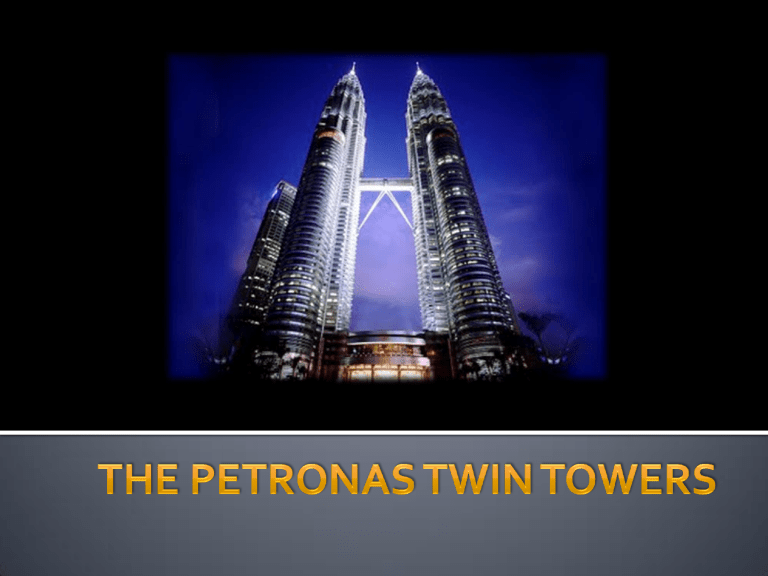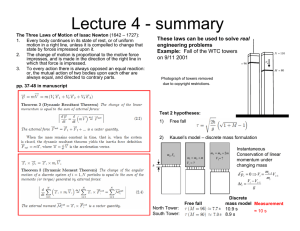Document 14104418

The Petronas Towers , also known as the Petronas Twin
Towers are twin skyscrapers in Kuala Lumpur, Malaysia.
According to the CTBUH's official definition and ranking, they were the tallest buildings in the world from 1998 to 2004 until surpassed by Taipei 101, but they remain the tallest twin building in the world.
The buildings are the landmark of Kuala Lumpur with nearby Kuala Lumpur Tower.
The towers were designed by Argentine architect
César Pelli. They chose a distinctive postmodern style to create a 21st-century icon for Kuala
Lumpur. Planning on the Petronas Towers started on
1 January 1992 and included rigorous tests and simulations of wind and structural loads on the design. Seven years of construction followed, beginning on 1 March 1993 with the excavation, which involved moving 500 truckloads of earth every night to dig down 30 metres (98 ft) below the surface.
The next stage was the single largest and longest concrete pour in Malaysian history. 13,200 cubic metres (470,000 cu ft) of concrete was continuously poured through a period of 54 hours for each tower. This record-breaking slab with 104 piles forms the foundation for each tower.
From this floor rose a 21-metre (69 ft) high retaining wall, with a perimeter length of over 1,000 metres
(3,300 ft). This concrete shell and the basement area it enclosed required two years to complete, and up to 40 workers on site 24 hours per day.
The construction of the superstructure commenced on 1 April
1994. Interiors with furniture were completed on 1 January
1996, the spires of Tower 1 and Tower 2 were completed on 1
March 1996, and the first batch of 'PETRONAS’ personnel moved into the building on 1 January 1997. The building was officially opened by the Prime Minister of Malaysia's Tun Dr.
Mahathir bin Mohamad on 1 August 1999.
The twin towers were built on the site of Kuala Lumpur's race track. Test boreholes found that the original construction site effectively sat on the edge of a cliff. One half of the site was decayed limestone while the other half was soft rock. The entire site was moved 61 metres (200 ft) to allow the buildings to sit entirely on the soft rock.
Because of the depth of the bedrock, the buildings were built on the world's deepest foundations. 104 concrete piles, ranging from 60 to 114 metres (200 to 374 ft) deep, were bored into the ground. The concrete raft foundation, comprising 13,200 cubic metres (470,000 cu ft) of concrete was continuously poured through a period of 54 hours for each tower. The raft is 4.6 metres (15 ft) thick, weighs 32,500 tonnes (35,800 tons) and held the world record for the largest concrete pour until 2007.
The foundations were completed within 12 months by Bachy Soletanche and required massive amounts of concrete. Its engineering designs on structural framework were contributed by Haitian engineer Domo
Obiasse and colleagues Aris Battista and Princess D Battista.
The Petronas Towers were the tallest buildings in the world for six years, until Taipei 101 was completed in 2004. The height of the towers is measured to the top of their structural components such as spires, but do not include antennas.
Spires are considered actual integral parts of the architectural design of buildings, to which changes would substantially change the appearance and design of the building, whereas antennas may be added or removed without such consequences. The Petronas Towers still remain the tallest twin buildings in the world.
The Petronas Towers and the Kuala Lumpur Tower dominate the skyline of Kuala Lumpur's Central Business District.
The Petronas's height compared to some other well-known tall structures.
Willis Tower (formerly Sears Tower) and the World Trade Center towers were each constructed with 110 occupied floors – 22 more than the 88 floors of the Petronas Towers. Willis Tower’s tallest antenna is 75.41 m (247.4 ft) taller than those of the
Petronas Towers, however, in accordance with CTBUH regulations and guidelines,the antennas of Willis Tower were not counted as part of its architectural features.
The spires on the Petronas Towers are included in the height since they are not antenna masts. Therefore, the Petronas Towers exceed the official height of Willis Tower by 10 m (33 ft) even though the roof of Petronas Towers at 378.6 metres (1,242 ft) is 63.4 m
(208 ft) lower than the roof of Willis Tower at 442 metres
(1,450 ft).
The Petronas Towers feature a diamond-faceted facade consisting of
83,500 square metres (899,000 sq ft) of stainless steel extrusions. In addition, a 33,000-panel curtain wall cladding system resides within the towers. While the stainless steel element of the towers entices the illustrious sun, highlighting the magnificent towers, they are composed of
55,000 square metres (590,000 sq ft) of 20.38-millimetre (0.802 in) laminated glass to reduce heat by reflecting harmful UV rays.
On the top of each tower is a pinnacle standing 73.5 metres (241 ft) tall.
The pinnacles were more than just the finishing touches to the height of the towers, each taking over 19 weeks to construct and both being assembled outside the country. One was constructed in Japan and the other in Korea. Each pinnacle is composed of 50 unique parts making up the main components: the spire, mast ball and ring ball. Together these parts weigh 176 tons. While the pinnacles may seem to be an aesthetic feature of the towers to enhance their presence and height, they also play function to aircraft warning lights and are an essential element to the overall Islamic minaret design that the towers embody
“The reality of a hollow object is in the void and not in the walls that define it. He was speaking, of course, of spiritual realities. These are the realities also of the Petronas Towers. The power of the void is increased and made more explicit by the pedestrian bridge that ... with its supporting structure creates a portal to the sky ... a door to the infinite.”
-César Pelli, architect (1995)






